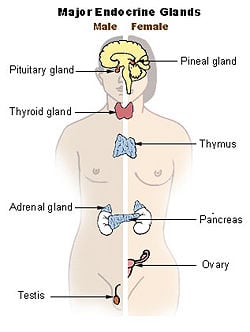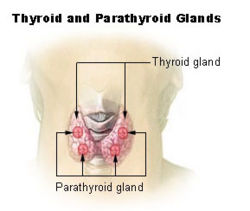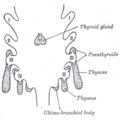Parathyroid gland
| Parathyroid gland | |
|---|---|
| Endocrine system. (Parathyroid gland not pictured, but are present on surface of thyroid gland, as shown below.) | |
| Thyroid and parathyroid. | |
| Latin | glandula parathyroidea inferior, glandula parathyroidea superior |
| Gray's | subject #273 1271 |
| Artery | superior thyroid artery, inferior thyroid artery, |
| Vein | superior thyroid vein, middle thyroid vein, inferior thyroid vein, thyreoidea ima |
| Nerve | middle cervical ganglion, inferior cervical ganglion |
| Precursor | neural crest mesenchyme and third and fourth pharyngeal pouch endoderm |
| MeSH | Parathyroid+Glands |
| Dorlands/Elsevier | g_06/{{{DorlandsSuf}}} |
The parathyroid glands are small endocrine glands in the neck, usually located behind the thyroid gland, which produce parathyroid hormone. In rare cases the parathyroid glands are located within the thyroid glands. Most often there are four parathyroid glands but some people have six or even eight.
Anatomy
The parathyroid glands are four or more small glands located on the posterior surface of the thyroid gland. They are quite easily recognizable from the thyroid as they have densely packed cells in contrast with the follicle structure of the thyroid. [1]
They distinguish themselves from the thyroid gland histologically as they contain two types of cells:[2]
| Name | Staining | Quantity | Size | Function |
| parathyroid chief cells | darker | many[3] | smaller | manufacture PTH (see below). |
| oxyphil cells | lighter | few | larger | function unknown.[4][5] |
History
The parathyroid glands were discovered by Ivar Sandstrom, a Swedish medical student, in 1880. [6] It was the last major organ to be recognized in humans.
Physiology
The sole function of the parathyroid glands is to regulate the calcium level in our bodies within a very narrow range so that the nervous and muscular systems can function properly.
When blood calcium levels drop below a certain point, calcium-sensing receptors in the parathyroid gland are activated to release hormone into the blood.
Parathyroid hormone (PTH, also known as parathormone) is a small protein that takes part in the control of calcium and phosphorus homeostasis, as well as bone physiology.
It then stimulates osteoclasts to break down bone and release calcium into the blood, and increase gastrointestinal calcium absorption.
Role in disease
The single major disease of parathyroid glands is overactivity of one or more of the parathyroid lobes which make too much parathyroid hormone causing a potentially serious calcium imbalance. This is called hyperparathyroidism; it leads to hypercalcemia and osteitis fibrosa cystica. Since hyperparathyroidism was first described in 1925, the symptoms have become known as "moans, groans, stones, and bones." The primary treatment for this disease is the surgical removal of the faulty gland.
Modern high frequency ultrasound can see parathyroid masses, even before they cause high calcium. They are called parathyroid incidentalomas. If a patient has elevated calcium, the ultrasound can be used to locate the abnormal glands. The use of ultrasound guided FNA, and parathyroid hormone washings can confirm the abnormal glands. A blood calcium 15-30 minutes after the biopsy can help determine if the disease is caused by a single abnormal gland or multiple glands.
A drop in serum calcium suggests a single source, and no drop suggests multiple glands. This, with a non-localizing Sestamibi scan would point toward a neck exploration, rather than a minimally invasive method aimed a single gland disease.
A Sestamibi scan is often used to determine which parathyroid gland(s) are responsible for overproduction of parathyroid hormone.
- Hypoparathyroidism
- Pseudohypoparathyroidism
- Pseudopseudohypoparathyroidism
- Disorders of the parathyroid hormone receptor have been associated with Jansen's metaphyseal chondroplasia and Blomstrand's chondroplasia.
Embryology and Evolution
The parathyroid glands originate from the interaction of neural crest mesenchyme and third and fourth pharyngeal pouch endoderm.
Genetically, Eya-1 (transcripitonal co-activator), Six-1 (a homeobox transcription factor), and Gcm-2 (a transcription factor) have been associated with the development of the parathyroid gland, and alterations in these genes alters parathyroid gland development.
The conserved homology of genes and calcium sensing receptors in fish gills with those in the parathryroid glands of birds and mammals is recognized by Evolutionary developmental biology as evolution using genes and gene networks in novel ways to generate new structures with some similar functions and novel functions.
Additional images
Human parathyroid glands
ReferencesISBN links support NWE through referral fees
External links
- Parathyroid surgery discussed by a UK specialist including minimal access surgery
- Parathyroid disease and treatments discussed in layman's terms at Parathyroid.com
- Endocrine Web at endocrineweb.com
- The origin of the parathyroid gland at pnas.org
- Human Gland Probably Evolved From Gills at pandasthumb.org
- The role of the endoderm in the development and evolution of the pharyngeal arches at blackwell-synergy.com
- Deep homologies in the pharyngeal arches at scienceblogs.com
- Template:EMedicineDictionary
- Template:USCHistology
- Template:IowaHistologyInteractive
| Endocrine system - edit |
|---|
| Adrenal gland | Corpus luteum | Hypothalamus | Kidney | Ovaries | Pancreas | Parathyroid gland | Pineal gland | Pituitary gland | Testes | Thyroid gland |
Credits
New World Encyclopedia writers and editors rewrote and completed the Wikipedia article in accordance with New World Encyclopedia standards. This article abides by terms of the Creative Commons CC-by-sa 3.0 License (CC-by-sa), which may be used and disseminated with proper attribution. Credit is due under the terms of this license that can reference both the New World Encyclopedia contributors and the selfless volunteer contributors of the Wikimedia Foundation. To cite this article click here for a list of acceptable citing formats.The history of earlier contributions by wikipedians is accessible to researchers here:
The history of this article since it was imported to New World Encyclopedia:
Note: Some restrictions may apply to use of individual images which are separately licensed.



